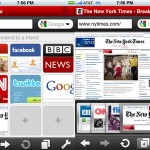-
Responsive Design – Great But Not The Holy Grail!!!
Let me start off by saying that this blog is NOT about undermining or questioning the value in a Responsive Design & Approach. In fact am in the middle of two reasonably sized responsive executions with a team of rock stars @ SapientNitro for leading brands and can’t wait to see them go LIVE. I…
-
Google Wallet with NFC
Originally published by: robgonda.com on 2012-05-25 16:27:05 by Rob Gonda Google officially rolled out its Google Wallet mobile payment system Monday. Is still in its infancy, but the system already shows a lot of promise. It uses a technology called NFC (Near Field Communication) to securely send your payments digitally. The only phone in the…
-
Approach to Responsive Design | User Experience in Context
I will admit that until last year, I perceived Responsive Design to be just a front-end development methodology, a combination of css media queries and javascript to deliver a ubiquitous web experience across devices, resolutions, screen sizes and orientations. A closer experience this year has made me realize the opportunities and challenges responsive brings –…
-
Smartphones Are First Choice For Second Screen
A clear majority of TV viewers (63%) are consulting a connected device while watching TV, a new IAB/Ipsos MediaCT study shows. But among those “second screeners” the smartphone was the most popular multitasking device among 45% of respondents — the tablet with 30% and the familiar computer with only 21%. The findings are part of…
-
Why is Big Data Revolutionary?
Originally published by: ZDNet » Tech on 2012-04-10 21:29 PDT by Andrew Brust Summary: Big Data is revolutionary, and not merely the evolution of BI and data warehousing technology. Here’s why. Last week, Dan Kusnetzky and I participated in a ZDNet Great Debate titled “Big Data: Revolution or evolution?” As you might expect, I advocated…
-
Save The Cleverness And Keep The CRM
When online marketers think about developing email campaigns, they typically focus on two areas: open rates and conversions. And the open rates, as we all know, have everything to do with subject lines. There’s no question that very clever subject lines give emarketers terrific open rates. We’ve seen them all, and at one time or…

